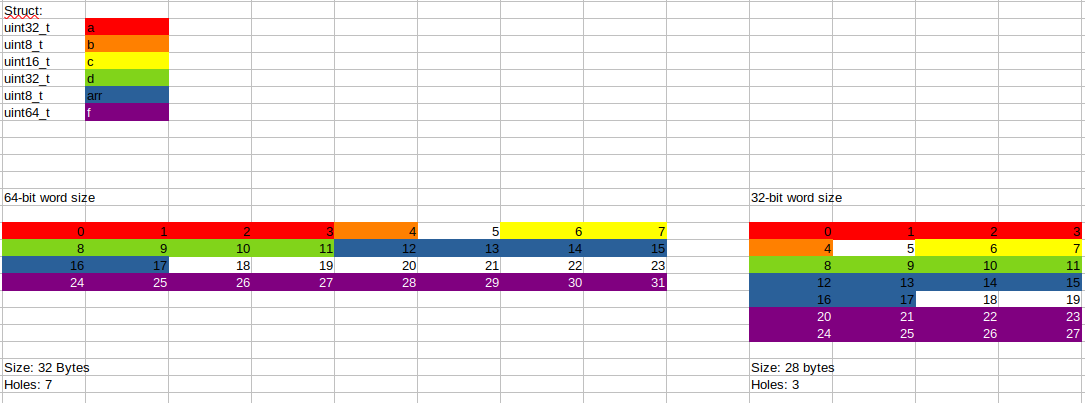A basic example of a C struct, and how the memory layout differs between 32-bit and 64-bit word size.
struct test_struct_t {
uint32_t a;
uint8_t b;
uint16_t c;
uint32_t d;
uint8_t arr[6];
uint64_t f;
};(see test.cpp)
make 64-bitg++ -g test.cpp -c -o test-64.o
make 32-bitg++ -g test.cpp -c -m32 -o test-32.o
Using pahole ("Poke-a-hole") to print memory layout
make print-struct-64pahole -C test_struct_t test-64.o
struct test_struct_t {
uint32_t a; /* 0 4 */
uint8_t b; /* 4 1 */
/* XXX 1 byte hole, try to pack */
uint16_t c; /* 6 2 */
uint32_t d; /* 8 4 */
uint8_t arr[6]; /* 12 6 */
/* XXX 6 bytes hole, try to pack */
uint64_t f; /* 24 8 */
/* size: 32, cachelines: 1, members: 6 */
/* sum members: 25, holes: 2, sum holes: 7 */
/* last cacheline: 32 bytes */
};
make print-struct-32pahole -C test_struct_t test-32.o
die__process_class: tag not supported 0x2f (template_type_parameter)!
struct test_struct_t {
uint32_t a; /* 0 4 */
uint8_t b; /* 4 1 */
/* XXX 1 byte hole, try to pack */
uint16_t c; /* 6 2 */
uint32_t d; /* 8 4 */
uint8_t arr[6]; /* 12 6 */
/* XXX 2 bytes hole, try to pack */
uint64_t f; /* 20 8 */
/* size: 28, cachelines: 1, members: 6 */
/* sum members: 25, holes: 2, sum holes: 3 */
/* last cacheline: 28 bytes */
};
This pragma packs the struct to 1-byte boundaries This could cause more complex assembly instructions / more overhead on some machines.
pack-64-bitg++ -g test-pack.cpp -o test-pack-64.o
pack-32-bitg++ -g test-pack.cpp -m32 -o test-pack-32.o
make print-pack-struct-64pahole -C test_struct_t test-pack-64.o
struct test_struct_t {
uint32_t a; /* 0 4 */
uint8_t b; /* 4 1 */
uint16_t c; /* 5 2 */
uint32_t d; /* 7 4 */
uint8_t arr[6]; /* 11 6 */
volatile uint64_t f; /* 17 8 */
/* size: 25, cachelines: 1, members: 6 */
/* last cacheline: 25 bytes */
} __attribute__((__packed__));
make print-pack-struct-32pahole -C test_struct_t test-pack-32.o
die__process_class: tag not supported 0x2f (template_type_parameter)!
struct test_struct_t {
uint32_t a; /* 0 4 */
uint8_t b; /* 4 1 */
uint16_t c; /* 5 2 */
uint32_t d; /* 7 4 */
uint8_t arr[6]; /* 11 6 */
volatile uint64_t f; /* 17 8 */
/* size: 25, cachelines: 1, members: 6 */
/* last cacheline: 25 bytes */
} __attribute__((__packed__));

